- S.D. Eibar ready for maiden La Liga outing
- SD Eibar stengthen ahead of debut La Liga season
- Can ‘Super Mario’ live up to expectations in Madrid?
- MAN IN THE GROUND – Brentford 0 – 4 Osasuna
- Historic Basque derby welcomes S.D. Eibar to La Liga
- Munich to Madrid, via Brazil – Tony Kroos
- Rakitic in Spanish Switch
- Can Spain find redemption in Rio?
- Viva Espana! A season of redemption for Spanish football
- From the old to the new: who can fill the void in years to come for La Roja?
Spotlight Season: Real Madrid, Barcelona and Alfredo di Stéfano – 1953-54
- Updated: 20 March, 2012
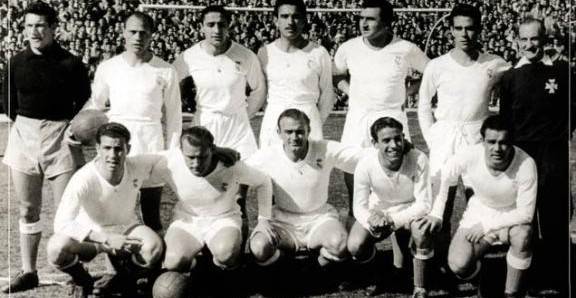
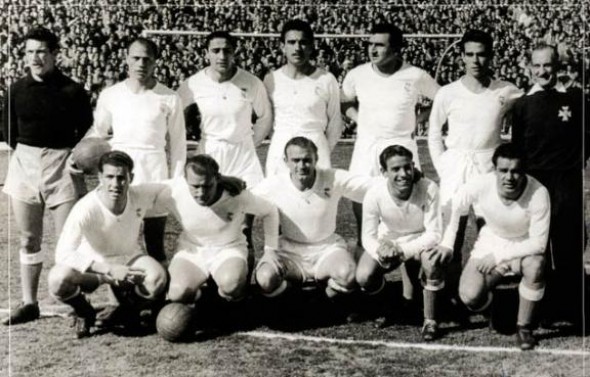
Real Madrid CF 1953-54
Background
It had been 21 years since Real Madrid’s last league triumph, during which time Los Merengues had stood by and watched Barcelona, Atlético Madrid, Athletic Club de Bilbao and Valencia accumulate more league titles. Much has been made of Real Madrid being Franco’s pet team, but the facts are clear, they had just two Copa del Generalísimo’s to their name during Franco’s first 15 years in power.
Luckily, club president Santiago Bernabeu knew a thing or two about football, having played for and then managed the club. Thanks to Bernabeu’s vision, planning and business acumen, Real Madrid was about to launch into a period of unprecedented dominance that would see it become the most successful club side of the twentieth century. The 1953-54 season saw the beginning of this dynasty.
The story of the campaign
Reigning champions Barcelona was favourite to retain the title, but during the summer, it had seen Real Madrid snatch Argentinian forward Alfredo Di Stéfano from under its nose. It was to prove to be a pivotal signing which would influence on the 53-54 season and beyond. Barca topped the table in the first two weeks, before Real Madrid edged ahead in week three.
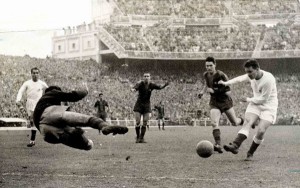 A defeat for Real Madrid at Sevilla in week 6 saw Barça return to the top, but in week seven, theBlaugranas travelled to Real Madid’s Chamartin stadium and was trounced 5-0. Neither team was convincing on their travels, with Barça in particular, losing at relegation bound Real Oviedo and Real Jaen. They did however regain the initiative in week 20, when Real Madrid drew in La Coruña, only to relinquish top spot a week later following defeat in Valencia.
A defeat for Real Madrid at Sevilla in week 6 saw Barça return to the top, but in week seven, theBlaugranas travelled to Real Madid’s Chamartin stadium and was trounced 5-0. Neither team was convincing on their travels, with Barça in particular, losing at relegation bound Real Oviedo and Real Jaen. They did however regain the initiative in week 20, when Real Madrid drew in La Coruña, only to relinquish top spot a week later following defeat in Valencia.
Real Madrid hung on to top spot, despite a 1-5 defeat at Barça’s Les Corts stadium, and with the Blaugranas continuing to be shoddy on the road, Real Madrid sealed the title with a game to spare, thanks to a 4-0 victory over Valencia and Barça’s surprise 1-4 defeat at home to Espanyol.
Significant matches
Whilst the two Real Madrid-Barcelona matches saw dramatic results, the 5-0 and 5-1 score lines effectively cancelled each other out. Far more decisive was the action at the other end of the table, where five clubs battled for survival. With two teams automatically relegated and a further two playing the top four teams from La Segunda’s two groups, the spectre of relegation was a distinct possibility for over half of the leagues clubs entering the final month of the season. With one match to play, the Asturians, Sporting Gijón and Real Oviedo were condemned, but a further six teams could still find themselves in a play-off for first division survival. These included the champions from 1950-51 Atlético Madrid, who had occupied bottom spot in the table for much of the first half of the season. In the end, despite none of the affected clubs losing, it was Osasuna’s failure to win at Valencia that sentenced them to the play-offs along with Real Jaen. Eventually, both Osasuna and Real Jaen were relegated.
Extras
The Alfredo Di Stéfano transfer saga dominated the pre-season, with Barcelona claiming that the player had reneged on an agreement to join them. Eventually, the Spanish Federation brokered an agreement whereby the player would play alternate seasons for Real Madrid & Barcelona. This was universally unpopular with Barcelona fans and ultimately cost club president Marti Carreto has job. Since opening in 1947, Real Madrid’s Estadio Chamartin had hosted the final of the Copa del Generalísimo. The competition was now played after the conclusion of the league and on 20 June 1954, Valencia beat Barcelona by 3 goals to nil.
For the record
Barcelona was the league’s top scorers with 74 goals, thanks in part to a 9-0 home win against Real Oviedo and scoring six goals on four other occasions. Bottom club Sporting Gijón conceded a league high of 81 goals, which included a 0-8 reverse at Valencia. Espanyol had the division’s meanest defence with 36 goals against, but the use of three goalkeepers during the campaign, meant that the clubs custodians cannot be considered for the Zamora award.
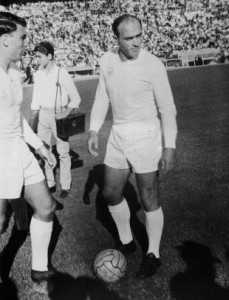 Pichichi
Pichichi
With 27 goals in 28 matches, Alfredo Di Stéfano comfortably won the Trofeo Pichichi. Barcelona never did take up the option on Di Stéfano, and the Argentine went on to win a further four Pichichi’s in an eleven-year career with Real Madrid, that saw him score 246 goals. He joined Espanyol in 1964 where a further 44 goals followed in 77 matches.
Zamora
Marca did not set up the Zamora Trophy until 1958, but this season’s top goalkeeper was Juan Ignacio Otero. The Deportivo La Coruña stopper conceded just 35 goals in the 25 matches that he played. Otero joined Real Betis in 1958 and Granada four years later. He retired from the game in 1966.
The Clubs today
Eleven of the clubs appear in this season’s top flight, with Real Madrid, Barcelona and Athletic Club having never left to top tier. Deportivo La Coruna, Celta Vigo and Real Valladolid are currently in La Segunda, whilst Real Jaen & Real Oviedo currently play their football in Segunda B.
Follow @icentrocampista

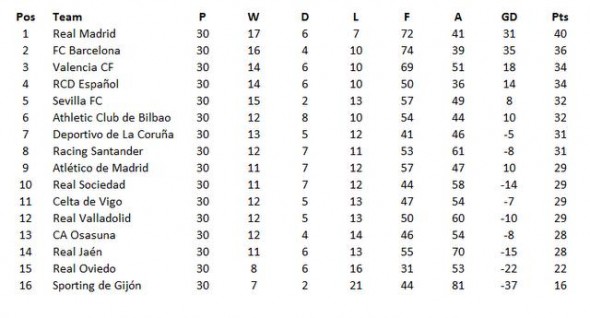
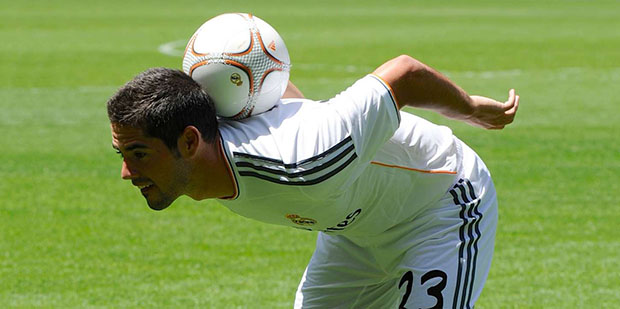
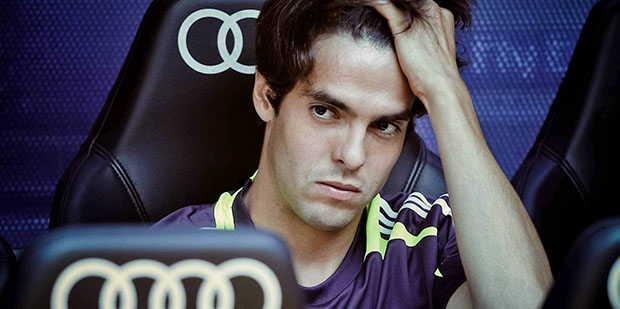
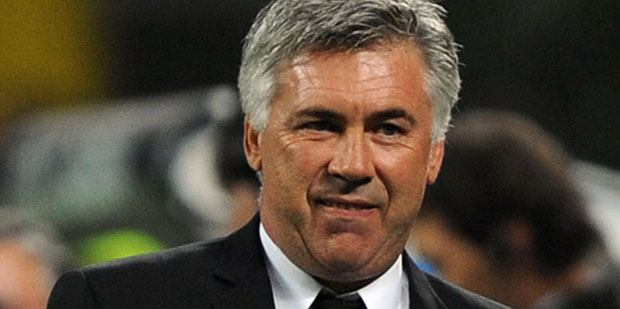


2 Comments
You must be logged in to post a comment Login